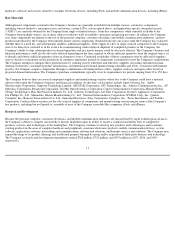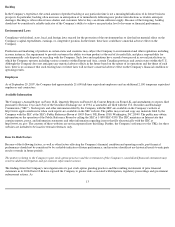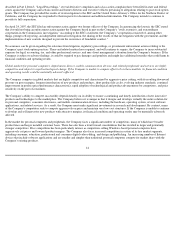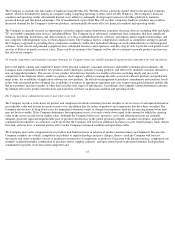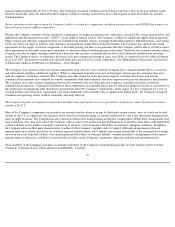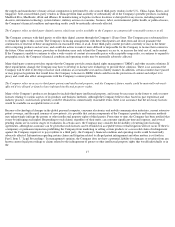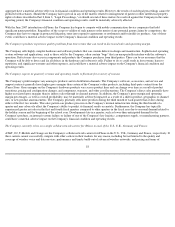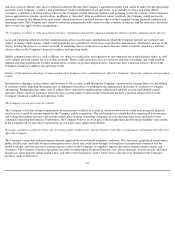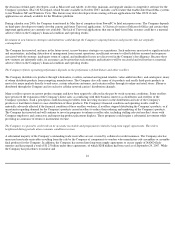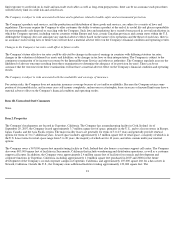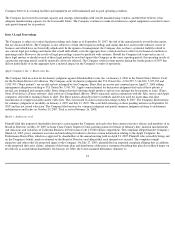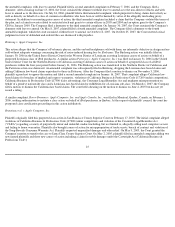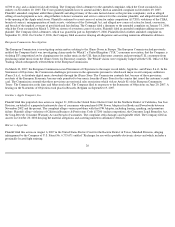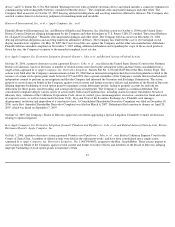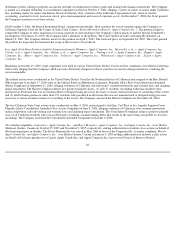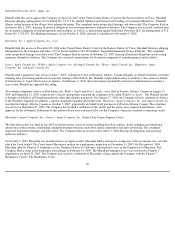Apple 2007 Annual Report Download - page 23
Download and view the complete annual report
Please find page 23 of the 2007 Apple annual report below. You can navigate through the pages in the report by either clicking on the pages listed below, or by using the keyword search tool below to find specific information within the annual report.
impossible for the Company to make and deliver products to its customers or to receive components from its suppliers, and create delays and
inefficiencies in the Company's supply chain. Should major public health issues, including pandemics, arise, the Company could be negatively
affected by more stringent employee travel restrictions, additional limitations in freight services, governmental actions limiting the movement of
products between regions, delays in production ramps of new products, and disruptions in the operations of the Company's manufacturing
vendors and component suppliers. The majority of the Company's research and development activities, its corporate headquarters, information
technology systems, and other critical business operations, including certain component suppliers and manufacturing vendors, are located near
major seismic faults. Because the Company does not carry earthquake insurance for direct quake-related losses and significant recovery time
could be required to resume operations, the Company's financial condition and operating results could be materially adversely affected in the
event of a major earthquake.
The Company's success depends largely on its ability to attract and retain key personnel.
Much of the Company's future success depends on the continued service and availability of skilled personnel, including its CEO, its executive
team and key employees in technical, marketing and staff positions. Experienced personnel in the technology industry are in high demand and
competition for their talents is intense, especially in the Silicon Valley, where the majority of the Company's key employees are located. The
Company has relied on equity awards as one means for recruiting and retaining this highly skilled talent. Recent accounting regulations requiring
the expensing of stock options have resulted in increased stock-based compensation expense, which has caused the Company to reduce the
number of stock-based awards issued to employees. There can be no assurance that the Company will continue to successfully attract and retain
key personnel.
Unfavorable results of legal proceedings could materially adversely affect the Company.
The Company is subject to various legal proceedings and claims that are discussed in Part I, Item 3, "Legal Proceedings." The Company is also
subject to other legal proceedings and claims that have arisen in the ordinary course of business and have not been fully adjudicated. Results of
legal proceedings cannot be predicted with certainty. Regardless of its merit, litigation may be both time-consuming and disruptive to the
Company's operations and cause significant expense and diversion of management attention. Should the Company fail to prevail in certain
matters, or should several of these matters be resolved against the Company in the same reporting period, the Company's financial condition and
operating results could be materially adversely affected.
The Company's business is subject to the risks of international operations.
The Company derives a large portion of its revenue from its international operations. As a result, its financial condition and operating results
could be significantly affected by risks associated with international activities, including economic and labor conditions, political instability, tax
laws (including U.S. taxes on foreign subsidiaries), and changes in the value of the U.S. dollar versus local currencies. Margins on sales of the
Company's products in foreign countries, and on sales of products that include components obtained from foreign suppliers, can be materially
adversely affected by foreign currency exchange rate fluctuations and by international trade regulations, including tariffs and antidumping
penalties.
The Company's primary exposure to movements in foreign currency exchange rates relate to non-U.S. dollar denominated sales in Europe,
Japan, Australia, Canada, and certain parts of Asia and non-dollar denominated operating expenses incurred throughout the world. Weaknesses
in foreign currencies, particularly the Japanese Yen and the Euro, can adversely affect demand for the Company's products and the U.S. dollar
value of the Company's foreign currency-denominated sales. Conversely, a strengthening in these and other foreign currencies can cause the
Company to modify international pricing and affect the value of the Company's foreign denominated sales and may also increase the cost of
product components.
20



